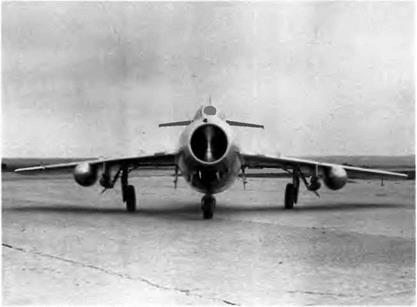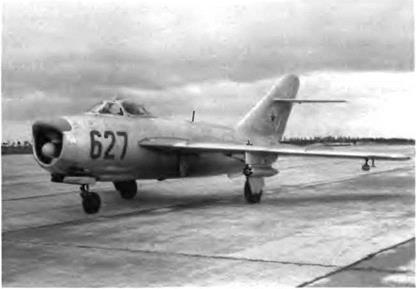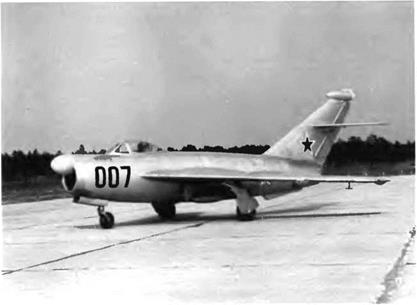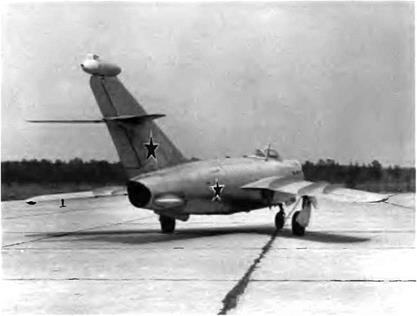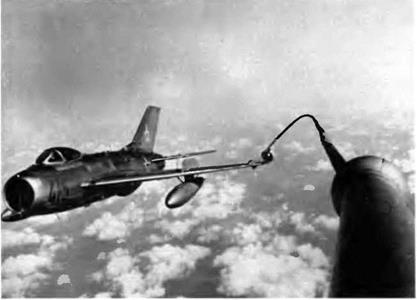The MiG-21M was the export version of the MiG-21SM. Soviet aircraft manufacturers never put their most recent engines or equipment into such models; consequently, the MiG-21 M was powered by the R-11F2S – 300 with 6,050 daN (6,175 kg st); the RP-22 radar was replaced by the RP-21MA (a modified RP-21M) linked to the ASP-PFD gunsight; and older RS-2US missiles were substituted for the R-3Rs. The maximum weapon load was 1,300 kg (2,865 pounds).
The MiG-21 M was mass-produced only for export in the MMZ Znamya Truda factory in Moscow between 1968 and 1971. India was granted the manufacturing license in 1971, and the first license-built MiG-21 M—referred to as Type 96—was delivered to the Indian air force on 14 February 1973 The aircraft continued to be built there until 1981.
Specifications
Span, 7.154 m (23 ft 5 7 in); fuselage length (except cone), 12 285 m (40 ft 3.7 in); wheel track, 2.787 m (9 ft 1.7 in); wheel base, 4.71 m (15 ft 5.4 in); wing area, 23 m2 (247.6 sq ft); takeoff weight, 8,300 kg (18,295 lb); max takeoff weight, 9,100 kg (20,055 lb); maximum takeoff weight on rough strip or metal-plank strip, 8,800 kg (19,395 lb); fuel, 2,200 kg (4,850 lb); wing loading, 360.9-395.7-382.6 kg/m2 (74-81.1-78.4 lb/sq ft); max operating limit load factor, 8 5.
Performance
Max speed, 2,230 km/h at 13,000 m (1,204 kt at 42,640 ft); max speed at sea level, 1,300 km/h (702 kt); climb rate at sea level (half internal fuel, full thrust) with two R-3S missiles, 115 m/sec (22,640 ft/min); climb to 16,800 m (55,100 ft) in 9 min; service ceiling, 17,300 m (56,740 ft); landing speed, 250 km/h (135 kt); range, 1,050 km (650 mi); with 800-1 (211-US gal) drop tank, 1,420 km (880 mi); takeoff roll, 900 m (2,950 ft); landing roll with SPS and tail chute, 550 m (1,800 ft).
|
The MiG-21MF was a modified MiG-21M powered by the same turbojet as the MiG- 21SM. This one is armed with two R-3S missiles and four bombs
|
The MiG-21MF was a modified MiG-21M reengined with the R-13-300 turbojet rated at 3,990-6,360 daN (4,070-6,490 kg st) and reequipped with the RP-22 Sapfir-21 radar of the MiG-21SM. The capacity of its fuel tanks was limited to 2,650 1 (700 US gallons), but the aircraft could cany either one 490-1 (129-US gallon) or one 800-1 (211-US gallon) drop tank under the fuselage and two 490-1 (129-US gallon) drop tanks under the wing. Like its predecessors, the MiG-21MF could be fitted with two SPRD-99 solid rocket boosters capable of 2,450 daN (2,500 kg st) apiece.
Armament included a built-in GSh-23L cannon with 200 rounds under the fuselage and, under the wing, four air-to-air missiles (two R – 3S and two R-3R), or two UB-32 and two UB-16 rocket pods (a total of ninety-six 57-mm S-5 rockets), or four 250- or 500-kg (550- or 1,100- pound) bombs, or any combination of these weapons, the maximum weapon load being 1,300 kg (2,865 pounds). The MiG-21 MF could also be armed with R-60 and R-60M air-to-air missiles for close combat.
The PVD-7 air data probe consisted of a ram air pressure inlet, three rows of static pressure pickups, and two pairs of weathercocks (one to measure the angle of attack [AOA] and the other to measure the sideslip angle). The pressure inlets fed the air data computer, and the weathercocks fed the fire control computer. It is noteworthy that these weathercocks had disappeared from the air data probe with the "old” MiG-21F. This probe did not normally send its data to the cockpit instrument panel—this task was left to a short Pitot head on the front starboard side of the fuselage—but it could serve as the primary Pitot – static probe in case of emergency. The pilot was informed via the instrument panel by the AOA indicator on the front port side of the fuselage. Other equipment included the AP-155 autopilot, the Sirena – 3M radar warning receiver, the SRO-2/SRZO-2 IFF transponder-interrogator, the SOD-57M decimetnc АТС transponder, the RV-UM radioaltimeter for 0-600 m (0-1,970 feet), the Lazur command receiver, and the new TS-27AMSh cockpit periscope.
The MiG-21MF was mass-produced in the MMZ Znamya Truda factory in Moscow between 1970 and 1974 and in the Gorki factory in 1975.
Specifications
Span, 7.154 m (23 ft 5.7 in); fuselage length (except cone), 12.285 m (40 ft 3.7 in); height, 4.125 m (13 ft 6.4 in); wheel track, 2.787 m (9 ft 1.7 in); wheel base, 4.71 m (15 ft 5.4 in); wing area, 23 m2 (247.6 sq ft); empty weight, 5,350 kg (11,790 lb); takeoff weight with four R-3S/R missiles and three 490-1 (129-US gal) drop tanks, 8,150 kg (19,725 lb); max takeoff weight with two R-3S/R missiles and three 490-1 (129-US gal) drop tanks, 9,400 kg (20 720 lb); fuel, 2,200 kg (4,850 lb); wing loading, 356.5-389 1-408.7 kg/m2 (73.1-79 8-83.8 lb/sq ft); max operating limit load factor, 8.5.
Performance
Max speed, 2,230 km/h at 13,000 m (1,204 kt at 42,640 ft); max speed at sea level, 1,300 km/h (702 kt); climb to 17,700 m (58,055 ft) in 9 min; service ceiling, 18,200 m (59,700 ft); landing speed with SPS, 270 km/h (146 kt); landing speed without SPS, 310 km/h (167 kt); range, 1 050 km (650 mi); with 800-1 (211-US gal) drop tank, 1,420 km (880 mi); with three 490-1 (129-US gal) drop tanks, 1,800 km (970 mi); hi-lo – hi radius of action, 370 km (230 mi) with four 250-kg (550-lb) bombs; 740 km (460 mi) with two 250-kg (550-lb) bombs; and two 490-1 (129- US gal) drop tanks; takeoff roll, 800 m (2,625 ft), landing roll with SPS and tail chute, 550 m (1,800 ft).











